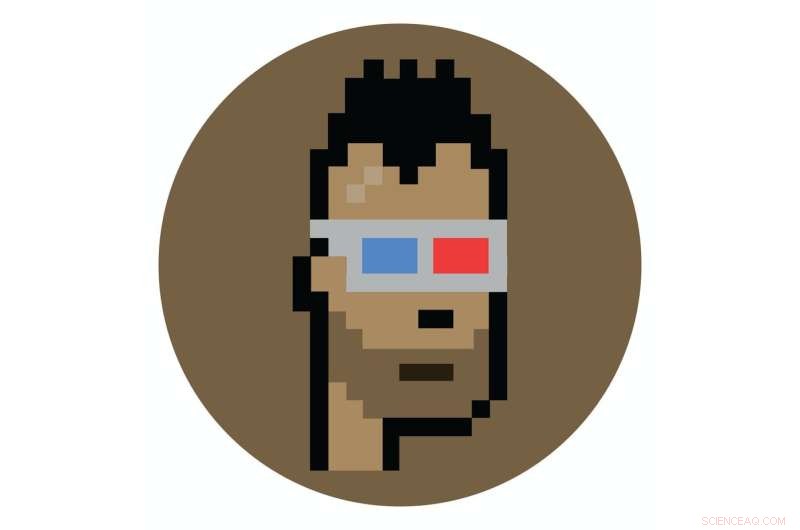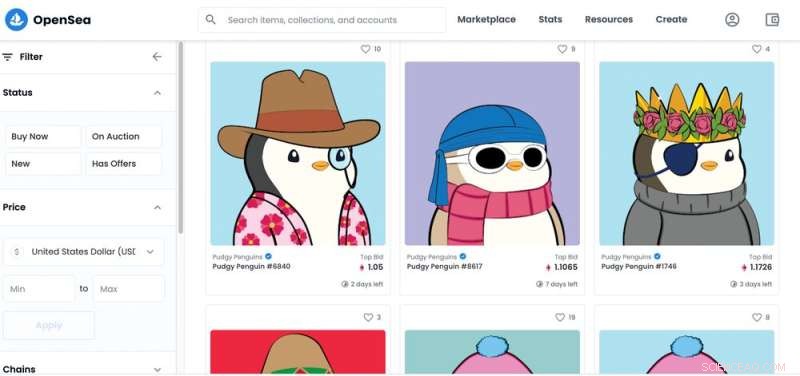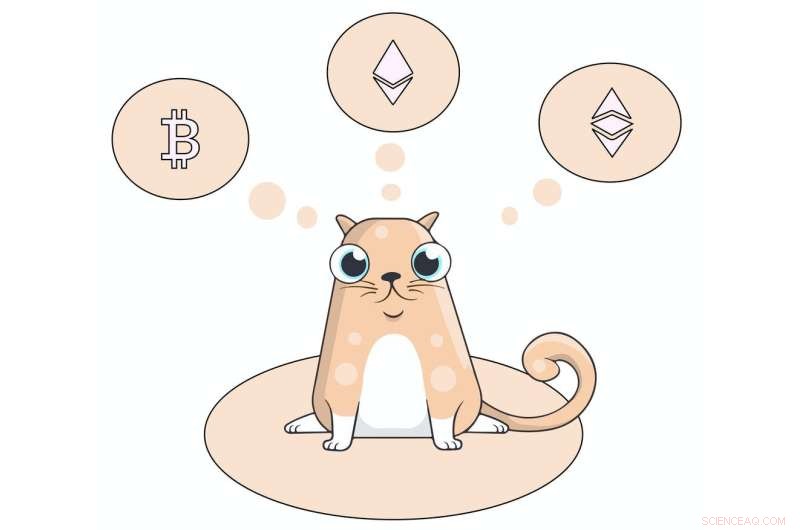
Bienvenido al mundo de la propiedad digital. Crédito:CreatorsTempe
Los NFT o tokens no fungibles capturaron por primera vez la imaginación del público cuando un collage digital de un artista llamado Beeple se vendió por 69 millones de dólares estadounidenses (51 millones de libras esterlinas) en Christie's en marzo de 2021. Desde entonces, ha habido una explosión en el uso de estas unidades. para almacenar contenido digital, que se compran y venden utilizando libros de contabilidad en línea conocidos como cadenas de bloques.
Desde esa conexión inicial con el arte, estamos viendo que las NFT se utilizan de muchas otras maneras. En particular, muchos se intercambian como coleccionables en intercambios como OpenSea y Rarible. Últimamente, por ejemplo, una serie de 8.888 adorables "Pingüinos regordetes" causó revuelo, cada uno reflejando su propia característica única, con una venta por un récord de 150 ethereum (alrededor de US$ 500.000).
Sin embargo, ya sea una obra de arte digital notable o un lindo pingüino digital, los NFT son esencialmente jpegs o gifs negociables. A diferencia de los coleccionables físicos, un propietario de NFT no podrá mostrar el activo en su hogar, excepto en una pantalla. Podrían pensar que podrían mostrarlo en un sitio web, pero este no es necesariamente el caso. Entonces, ¿qué obtiene alguien realmente cuando compra un NFT y qué es lo que realmente posee desde una perspectiva legal?
La nueva frontera
Para comprender las NFT, es importante comprender qué se entiende por "fungible". Fungible se deriva del verbo latino fungi , que significa realizar. En el contexto más amplio, esto significa intercambiable y se relaciona con si algo se puede intercambiar.
El dinero es fungible, en el sentido de que puedes comprar una mercancía por valor de 10 libras esterlinas con cualquier billete de 10 libras esterlinas; no importa cuál uses. Por otro lado, los NFT no se pueden intercambiar de igual a igual con otro. Son cada uno de un tipo, o uno de una edición limitada.
El contenido vendido como NFT se puede crear de muchas maneras. Puede ser generado por computadora, que fue la base para la producción de 10 000 CryptoPunks únicos en 2017.
Puede reflejar un trabajo colaborativo, como la serie de NFT musicales de la cantautora inglesa Imogen Heap, "Firsts". Estos involucraron su improvisación junto con imágenes proporcionadas por el artista Andy Carne. O los NFT pueden representar una sola obra, como la obra de arte de Beeple; o una serie de artículos, como la serie "NFT Yourself" de Kings of Leon, en la que los activos que se ofrecían incluían álbumes de música con características únicas y entradas especiales para conciertos.

Pssst, ¿te apetece un pingüino? Crédito:OpenSea
Derechos limitados
Los NFT permiten al propietario de una obra o colección limitada llegar a su audiencia directamente. Mientras que antes no era posible vender algo como el primer tuit, un gif con el tema de un taco o, de hecho, una obra de arte en línea, ahora las personas, empresas u organizaciones culturales pueden hacerlo siempre que sean los propietarios legítimos.
El creador puede hacer esto porque, de acuerdo con la ley de derechos de autor del Reino Unido, los derechos de autor surgen automáticamente cuando se crea un trabajo, siempre que refleje la "creación intelectual propia del autor". Esto significa que el creador de una obra es el propietario de los derechos de autor y puede hacer lo que quiera con ella.
Cuando alguien compra un NFT del creador, obtiene la propiedad en el sentido de que se convierte en su propiedad. After all, an NFT is a digital certificate of ownership representing the purchase of a digital asset, traceable on the blockchain.
But the NFT holder does not have any other rights to the work. This includes those offered under copyright law, such as the right of communication to the public (in other words, making the asset available to the world at large), or the rights of adaptation or reproduction.
The situation is the same if you buy a physical collectable. Owning a painting does not automatically give you the right to display it in public. It also doesn't give you the right to sue for infringement of copyright if someone reproduces the image in the painting without permission. To obtain such rights, you either need to be the copyright owner of the work or have the copyright assigned to you by the creator (in writing and signed).
The trouble with online content is that, by virtue of its digital nature, it is easy to share, copy and reproduce. Buyers of NFTs need to understand that they would be infringing the copyright if they engage in such activities without the permission of the right holder. The only way such rights can be transferred is through the terms embedded in the NFT, in the form of a license.

CryptoKitties allow owners to make up to US$100,000 a year from them. Credit:Vector Factory
There have been some NFTs where the buyer has been granted the right to use the copyright in a limited way. For example, owners of CryptoKitties NFTs have been allowed to make up to US$100,000 in gross revenues from them each year. In other cases, creators have specifically restricted all commercial use of the work. For example, the Kings of Leon stipulated that their NFT music was for personal consumption only.
Buyers therefore need to be clear that the main reasons to buy an NFT are the speculative investment and the pleasure of having something unique from an admired artist, brand, sports team, or whatever. Unless the terms allow it, buyers will only have a limited ability to share the creative work on public platforms or to reproduce it and make it available for others.
Incidentally, buyers should also be aware that the blockchain cannot absolutely know whether a creative work is authentic. Someone can take another person's work and tokenise it as an NFT, thereby infringing the rights of the copyright owner. You need to be sure that you are buying something that originated from the creator.
In short, NFTs are probably here to stay, but they clearly raise ownership questions relating to copyright law. This may not be immediately clear to most people, and it's important that you understand the limits of what you are getting for your money.